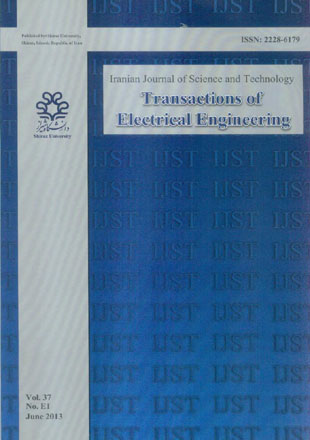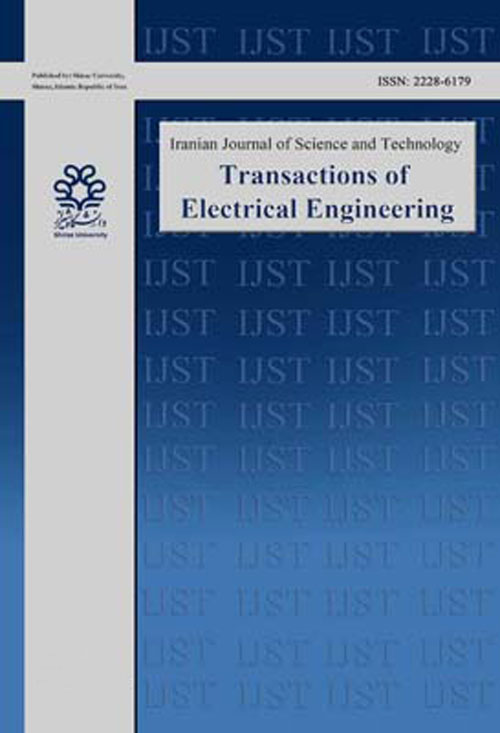فهرست مطالب

Iranian Journal of Science and Technology Transactions of Electrical Engineering
Volume:37 Issue: 1, 2013
- تاریخ انتشار: 1392/03/12
- تعداد عناوین: 7
-
-
Pages 1-16Subspace Pursuit (SP) is an efficient algorithm for sparse signal reconstruction. When the interested signal is block sparse, i.e., the nonzero elements occur in clusters, block sparse recovery algorithms are developed. In this paper, a blocked algorithm based on SP, namely Block SP (BSP) is presented. Contrary to the previous algorithms such as Block Orthogonal Matching Pursuit (BOMP) and mixed 2 1 l /l -norm, our approach presents better recovery performance and requires less time when non-zero elements appear in fixed blocks in a particular hardware in most of the cases. It is demonstrated that our proposed algorithm can precisely reconstruct the blocksparse signals, provided that the sampling matrix satisfies the block restricted isometry property - which is a generalization of the standard RIP widely used in the context of compressed sensingwith a constant parameter. Furthermore, it is experimentally illustrated that the BSP algorithm outperforms other methods such as SP, mixed 2 1 l /l -norm and BOMP. This is more pronounced when the block length is small.Keywords: Subspace pursuit, block sparsity, compressed sensing, block RIP
-
Pages 17-33One of the prevalent methods to increase the network lifetime is to develop the uniformity in the sensor node distribution and load balancing. The existing criteria to calculate the uniformity are only able to locally or globally measure the uniformity of sensor distribution in the network. In this paper, a new criterion is proposed for the uniformity measurement of sensor distribution. The criterion can calculate the both global and local uniformity in various levels of node distribution. In addition, using the model of sensing area of each sensor, this criterion has been generalized for the uniformity of sensors energy distribution in the network via calculating the uniformity of sensor node distribution. In order to assess the performance of the proposed criterion, a set of sensor distribution patterns has been utilized; also, the uniformity calculation results of these patterns have been studied. Then, a method for the sensor assignment has been proposed in a network, in which sensor nodes have the possibility of rotation and a coverage area is selected. This method enhances the energy distribution uniformity in the network. The comparison is finally provided among the perceived results to show an acceptable performance of the proposed method.Keywords: Uniformity measurement, global uniformity, local uniformity, directional sensor networks, uniformity maximization
-
Pages 35-49To attract more investments for developing smart transmission networks and increasing their flexibility and efficiency، recently policies have been suggested which provide financial incentives in transmission network investment. One of these policies is price biding for incremental transmission capacity and transmission elements in power markets. According to Federal Electricity Regulatory Committee، flowgate bidding is defined as allowing a line’s flow to exceed its rated capacity for a short period of time for a set penalty، i. e.، price. This paper concentrates on the development of a comprehensive model for flowgate bidding and Dispatchable Transmission Services (DTS) in security constraint unit commitment. DTS and flowgate biddings are used during contingencies and steady state to determine optimal required energy and reserve values. As the scale of the problem is large، the benders decomposition algorithm is used to solve the problem. To investigate the efficiency of the proposed strategy، IEEE 6 and 24 bus case tests are studied. According to the obtained results، this strategy decreases energy and reserve marginal prices، as well as reliability cost. Furthermore، the suggested plan is an incentive to the owners of transmission companies.Keywords: Smart flexible transmission service, flowgate bidding, dispatchable transmission services
-
Pages 51-65As a result of the increasing popularity of social networking websites like Facebook and Twitter, analysis of the structure of these networks has received significant attention. The most important part of these analyses is towards detecting communities. The aforementioned structures are usually known with extremely high inter-connections versus few intra-connections in the graphs. In this paper, in spite of most approaches being optimization based, we have addressed the community detection problem (CDP) by a novel framework based on Information Diffusion Model and Shapley Value Concept. Here, each node of the underlying graph is attributed to a rational agent trying to maximize its Shapley Value in the form of information it receives. Nash equilibrium of the game corresponds to the community structure of the graph. Compared with the other methods, our approach demonstrates promising results on the well-known real world and synthetic graphs.Keywords: Social network, Shapley value, information diffusion, Nash equilibrium, community structure
-
Pages 67-77In the present study, we propose a novel clustering-based method for modeling accurate fuzzy rule-based classification systems. The new method is a combination of a data mapping method, subtractive clustering method and an efficient gradient descent algorithm. A data mapping method considers the intricate geometric relationships that may exist among the data and computes a new representation of data that optimally preserves local neighbourhood information in a certain sense. The approach uses subtractive clustering method to extract the fuzzy classification rules from data; the rule parameters are then optimized by using an efficient gradient descent algorithm. Twenty datasets taken from UCI repository are employed to compare the performance of the proposed approach with the other similar existing classifiers. Some non-parametric statistical tests are utilized to compare the results obtained in experiments. The statistical comparisons confirm the superiority of the proposed method compared to other similar classifiers, both in terms of classification accuracy and computational effort.Keywords: Pattern classification, Fuzzy rule extraction, Subtractive clustering
-
Pages 79-92Artificial Bee Colony (ABC) is one of the recently introduced optimization methods based on intelligent behavior of honey bees. In this work, we propose an Adaptive Multi Objective Artificial Bee Colony (A-MOABC) Optimizer which uses Pareto dominance notion and takes advantage of crowding distance and windowing mechanisms. The employed bees use an adaptive windowing mechanism to select their own leaders and alter their positions. Besides, onlookers update their positions using food sources presented by employed bees. Pareto dominance notion is used to show the quality of the food sources. Those employed or onlooker bees which find food sources with poor quality turn into scout bees in order to search other areas. The suggested method uses crowding distance technique in conjunction with the windowing mechanism in order to keep diversity in the external archive. The experimental results indicate that the proposed approach is not only thoroughly competitive compared to other algorithms considered in this work, but also finds the result with satisfactory precision.Keywords: Multi, objective optimization, artificial bee colony, crowding distance, windowing mechanism
-
Pages 93-100One of the fundamental methods used in collaborative filtering systems is Correlation based on K-nearest neighborhood. These systems rely on historical rating data and preferences of users and items in order to propose appropriate recommendations for active users. These systems do not often have a complete matrix of input data. This challenge leads to a decrease in the accuracy level of recommendations for new users. The exact matrix completion technique tries to predict unknown values in data matrices. This study is to show how the exact matrix completion can be used as a preprocessing step to tackle the sparseness problem. Compared to application of the sparse data matrix, selection of neighborhood set for active user based on the completed data matrix leads to achieving more similar users. The main advantages of the proposed method are higher prediction accuracy and an explicit model representation. The experiments show significant improvement in prediction accuracy in comparison with other substantial methods.Keywords: Recommender systems, collaborative filtering, Correlation, matrix completion, convex optimization, nearest neighborhood


